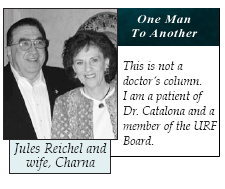Surgery Plus Radiation When Required: Is It the Best Choice?
 A Univeral Approach
A Univeral Approach
My prior article in QUEST, Winter 2005, described a “universal” approach to achieving a high likelihood of long-term remission and a return to a positive life for a wide range of prostate cancer patients who have low-risk to high-risk disease.
The approach is based on the use of early intervention with surgery (prostatectomy), followed– if required by either likely or observed recurrence– with suitable radiation therapy.
Using such a protocol, one would anticipate 5-year non-recurrence rates in the 90% range for Dr. Michael Bolla’s high-risk cases (Bolla 2005; Europe). Lower risk cases will be even more favorable.
Reader comments made it clear to me that a follow-up article was needed to discuss two important alternatives to the suggested approach:
Alternative #1
Despite my misgivings about long-term use of hormonal therapies, they are in frequent use. Their difficult side effects and limited ability to achieve cure are balanced against their benefits.
Users of hormonal therapies would like to know whether they work better or worse when combined with surgery?
Alternative #2
Radiation therapy is the follow-up part of the suggested approach.
Users of radiation therapies would like to know whether they can just use radiation therapy strategies and avoid surgery?
Expert doctors view the evaluation of these alternatives as controversial and not yet settled medicine. In addition my comments exclude highly advanced cases that often require other therapies. This article only provides my evaluations as an informed layman and patient.
Recurrence
During the 15 years after primary treatment (whether using surgery or radiation) many men (maybe 1/3 of patients-the exact number is disputable) will have clear signs of recurrent disease.
The treatment of recurrence will require the use of one or more additional therapies. What to do next is a lot easier to answer if the original plan for treatment included the possibility of recurrence.
The breadth of response over a lifetime, including the possibility of recurrence, is why Dr. Bolla’s work is transformational. He validated that surgery and follow-up radiation, if required by likely or observed recurrence, fit together like a hand and glove. Almost all cases can be handled and the long-term outcomes are excellent.
The important question not addressed by Dr. Bolla’s recent paper is whether patients with adverse pathology in the prostatectomy specimen should have adjuvant radiotherapy as soon as possible (usually 3 to 4 months after surgery) or wait until there is evidence of PSA progression. Nobody knows the answer to this important question.
Alternative #1: Hormonal therapies and surgery
Testosterone is the primary male hormone. It is associated with all of the qualities that we usually think of as maleness, and it also affects the good health and vitality of the whole body.
Hormone therapy is concerned with slowing or stopping cellular growth of cancer by depriving the body of testosterone and its other most potent form, dihydrotestosterone. This deprivation is called androgen deprivation therapy (ADT). Nowadays it is primarily done with drugs such as Lupron, Zoladex, Casodex, and many others.
ADT sometimes has intense side effects that men report to be very difficult to live with. These side effects are important to consider as part of the therapy plan, but having extended life is clearly more important, and ADT is often the best if not the only therapy available for some situations.
One concern of hormonal therapy is predicting how long the treatment will be effective. Hormone-independent cells eventually become strong enough that hormone therapies have less and less of an effect on the growth of the tumor. In time, the ADT can stop being effective, and the patient is said to be “hormone refractory”. ADT therapy can be effective for a few years or in some cases it can work for 15-20 years. At the present, no one can predict the outcome for individual cases.
One of the strongest advocates for an optimistic view of ADT-related survival is Dr. Charles Myers (medical oncologist). Myers recently cited the results of Dr. Horst Zincke of the Mayo Clinic, in his journal, Prostate Forum.
He wrote that patients with something as severe as metastasis to the lymph nodes only avoided becoming hormone refractory for about 7-8 years. However, if the prostate had been previously removed by surgery, 50-95% of men were not hormone refractory at 10 years. The variation depends on the number of lymph nodes that are involved.
Myers explanation for this startling observation is: “You would expect hormone resistance to emerge at locations where there are a large number of cancer cells. If the prostate gland is an important source of hormone resistant prostate cancer, then removing the prostate should improve hormone therapy’s results.” And indeed, Dr. Zincke “makes it a practice to remove the prostate gland in patients with lymph node metastases.”
Considering the question of whether hormonal therapies work better or worse after surgery: It appears to me that hormonal therapy can work better after the prostate has been surgically removed. As with all controversial items, some expert doctors will not agree.
Surgery plus radiation, if required, is still a strong option, even if hormonal therapy is used in some phase of the therapy plan.
Alternative #2: Why not radiation therapies only?
Both surgery and modern radiation therapy are well-established methods for treating localized prostate cancer. Although it’s difficult to compare the two approaches because they use different methods for evaluating successful treatment, it is generally believed that both therapies can produce cure in most patients.
Some patients inaccurately view radiation therapies as “magic beams” with no issues of recurrence. It’s not true; recurrence rates are similar to or higher than those from surgery.
Can treatment be equally “universal” by skipping the surgery and only using a variety of radiation techniques? Probably not. Radiation therapy has no currently successful answer to the difficult problem of recurrence.
Two Experts Describe the Problem
For 15 years, Dr. Zincke, from Mayo Clinic, has studied stage cT3 prostate cancer (cancer that has spread locally beyond the prostate). Some urologists refer such patients for radiation therapy, but Zincke found that when these patients are surgically treated, they survive much longer than patients given radiation therapy.
The explanation for the poorer performance of radiation therapy is that in the PSA era, most cT3 patients have higher-grade, more aggressive tumors that are frequently unresponsive to therapeutic doses of radiation.
Beginning treatment with radiation therapy creates the risk of failure to kill all of the cancer cells in the prostate. These risks are, however, becoming lower for patients who follow early screening guidelines, since there are fewer cT3 cases.
Dr. Stephenson, of Memorial Sloan-Kettering Cancer Center, studied the reverse protocol to the one that I have suggested, namely, radiation therapy first, followed, if required, by salvage surgery. He reported (J Clin Oncol, 2005) two serious problems:
Using ASTRO (Amercian Society of Therapeutic Radiation Oncology) definitions of recurrence resulted in declaring recurrence so late that local salvage surgery was not effective.
A second related problem was that radiation treatment is often accompanied by the use of hormonal therapies making it even more difficult to recognize recurrence at an early stage.
Stephenson also looked at the option of replacing the follow-up surgery with cryosurgery. However, once again there were problems: namely, cryosurgery was less successful than surgery at removing cancer, and it could not reach the bed of the prostate as radiation therapy can.
Considering the question of whether a radiation-only approach is equally universal: My answer is NO, not at this time, although, as with all controversial topics, some expert doctors will not agree.
Surgery plus radiation, if required, is a strong option.
Bottom line
Each patient should make his own medical choices. Any treatment that a man prefers and works for him is surely a good treatment. It takes many years for the medical community to converge on “best” treatments and the issues in this article have strong and credible advocates pulling in different directions.
However, in my opinion, for the full range of disease at diagnosis, and when looked at over a lifetime, the protocol of surgery plus radiation, if required, still seems to be a very strong approach to treatment.











